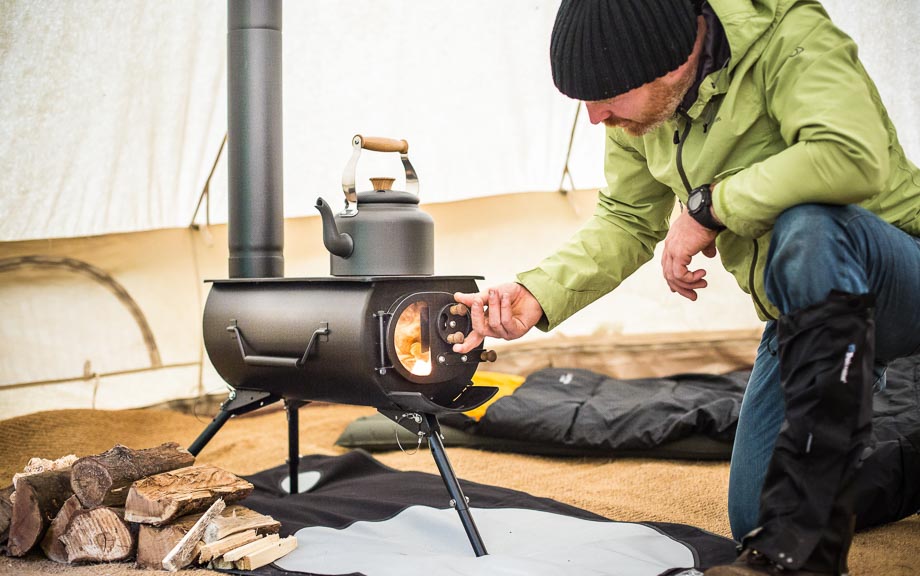How Tent Stoves Work

Product Featured: Frontier Plus Portable Stove
Understanding how a tent stove works will help you make an informed decision when deciding which tent stove is right for you. Having a solid understanding of how a tent stove works, the formula of fire, and tent stove components will also help you operate a wood stove safely and troubleshoot issues in the field. Learn more about fire, tent stove features, and how portable wood burning tent stoves function to stay cozy while camping.
THE FORMULA FOR FIRE
The formula for fire is simple: fuel and oxygen combine in a chemical processes known as combustion which produces energy in the form of heat and light (fire) and waste (smoke, ash, coal). Stoves help regulate combustion and keep fuel and waste contained while emitting heat. The heat emitted by the stove is then contained by the tent surrounding it for the enjoyment of the people inside it. Understanding how each of the variables influence each other is critical when choosing a tent stove and operating one.
Fuel
Although almost everything in the physical world we occupy is capable of burning, wars have been fought in pursuit of good wood. High quality fuel burns more completely than low quality fuel, producing more energy and less waste. Wet or green wood fails to produce enough energy to overcome all of the moisture it contains, resulting in waste in the form of smoke and creosote. Dry wood burns cleanly and easily when exposed to enough oxygen. Softwoods and pitchy trees tend to burn hot and fast, hardwoods are denser and burn lower and slower.
Oxygen
In a tent stove the flow of air serves two very important functions; sustaining combustion and expelling gasses. Air enters the stove through the door or intake to feed the fire, then rises carrying airborne waste (smoke) up the flue pipe to be dispersed into the outside environment. The hot air rising out of the flue pipe creates a vacuum that sucks in fresh air – an airflow pattern known as “draft” and/or “draw”. See our troubleshooting section below fore more information on troubleshooting draw or draft issues.
Energy
Fire is energy in the form of heat and light. Some tent stoves are equipped with tempered glass windows to emit light, ALL tent stoves are designed to emit heat. Tent stoves capture, store, and radiate heat energy for two purposes: combustion and heat distribution. Radiating heat back into a fire increases the percentage of fuel converted into energy and reduces the percentage wasted – improving combustion efficiency. Radiating heat into the tent increases percentage of heat available for use and reduces the percentage lost to the outside environment – improving heat efficiency.
Waste
Fire produces a variety of byproducts that range from useful to dangerous. Smoke is a combination of airborn particulate and volatile gases, including carbon monoxide which is colorless, odorless, and deadly. Ash, soot, and creosote are the unburnable minerals and chemicals present in, or on, wood prior to burning. Char is primarily carbon, wood which has had much of the moisture and non-carbon material cooked out of it. Although some waste is unavoidable, minimal waste is a good indicator of an efficient stove and quality fuel. Unburnt chunks of wood or char in a tent stove represent an energy opportunity loss.
FUNCTIONS OF A TENT STOVE
Tent stoves convert wood fuel into useful heat energy by promoting combustion and then radiating heat. The best way to understand a tent stove is by comparing it to an open fire. A standard campfire releases gas and heat immediately into the atmosphere while leaving behind a good deal of unburnt material. A tent stove concentrates air, fuel, heat, and waste so it can be burnt to produce more heat, instead of being lost to the atmosphere. The more completely fuel is burned, the more energy is produced which is called combustion efficiency. A tent stove is 10 to 20 times more efficient at burning than an open fire.
Where the heat from an open fire rises and dissipates into the open air, the materials the tent stove and flue pipe are made of capture heat emitted by the fire and smoke. That heat energy is momentarily ‘stored’ in the tent stove then radiates from it. Heat radiating back into the firebox and flue pipe raises the temperature of the fuel, fire, air, and waste – promoting further combustion. Heat radiating from the tent stove into the ambient environment is called heat transfer. The tent surrounding the tent stove traps the heat transferred from the wood burning stove, while allowing toxic gases and harmful particulate produced by the fire to escape. The more heat is stored and emitted by the stove, the more useful energy is captured which is called heating efficiency or heat transfer efficiency.
Understanding the differences between combustion efficiency and heating efficiency is important when choosing, installing, and operating a tent stove. Although wood stoves have a higher combustion efficiency than an open fire, not all wood burning stoves are good at transferring heat. The design and construction of portable wood stoves heavily influences how a stove functions.
TENT STOVE PARTS AND FEATURES
Although all tent stoves share the same basic components, additional features are often added to their design to improve performance and/or convenience. Master the art of hot tenting by understanding the different parts of a tent stove and how those parts influence operation, efficiency, and east of use. Explore the list below to learn more about stove components, how they vary, and what quality indicators to look for when shopping for a stove.
Standard Components
Firebox
The combustion chamber where wood fuel is burnt to generate heat. Fireboxes form the ‘body’ of the stove where all the action takes place and vary by size, shape, and material.
Size: Large fireboxes hold and burn more wood. Smaller fireboxes are easier to transport but typically need to be fueled more often. A larger fire does produce more heat, although a larger tent stove does not necessarily burn more efficiently or provide more heat transfer than a smaller stove of higher quality.
Shape: Cylinder stoves are traditionally tube shaped which are easy to clean and heat evenly. Most cylinder stoves are not true cylinders and instead have a flat surface on top for cooking giving the firebox a U shape. Box shaped stoves with flat surfaces all around are the preferred design for high end stoves equipped with tempered glass and/or firebrick lining. Collapsible fireboxes that ‘fold flat’ are typically boxed shaped, although the few inches of space saved by an folding tent stove is often less efficient but equally cumbersome than a fixed wall stove in which flue pipe sections can be stored for transport.
Material: What the firebox is made of influences efficiency, durability, weight, and cost. Tent stoves are typically made of high temperature and corrosion resistant metal or alloy, including cast iron, stainless steel, aluminum, nickel, and/or titanium. Each material has pros and cons and can be beneficial for different applications.
- Aluminum tent stoves are cheap and lightweight – and that’s where there benefits end. Tent stoves made of aluminum are not very durable and can dent or scratch easily. Aluminum has high thermal conductivity which means it heats quickly, unevenly, and does not retain heat.
- Titanium tent stoves are extremely durable and lightweight and are ideal for ultralight backpacking applications. Although titanium is expensive, the additional cost is justified when shaving every last ounce of weight off your pack is important. Added strength and expense lend to thin walls in titanium tent stoves which is great for portability but less than ideal for even heating and heat retention.
- Stainless steel is the material of choice for most tent stoves because it strikes a great balance between cost, durability, and weight. Fireboxes made of steel are typically thicker than aluminum or titanium stoves, offering more even heating and heat retention. Steel wood stoves are certainly heavier than backpacking tent stoves, but no heavier than a cooler making them ideal for 80% of camping applications.
- Cast Iron tent stoves provides the most heat retention but are extremely heavy. Cast iron has very low thermal conductivity – it will take a long time to heat up, but once it’s up to temperature it holds and radiates heat for a long time. Although cast iron is generally pretty affordable, poorly made cast iron can crack so choose a reputable manufacturer. Cast iron can also rust when exposed to moisture, a rubbing a thin layer of cooking oil on as it cools down after a fire should keep it excellent condition for generations.
Door
Sealable entry to the firebox used to add fuel and remove ash. Quality stoves equipped with snug fitting doors and sealed gaskets rely on air intake vents and controls to regulate oxygen delivery. Ultralight stoves or cheap stoves may rely on loose door seals to introduce oxygen. All tent stoves should have some sort of securable door, although a few minimalist designs omit the door entirely.
Flue Pipe
Chimney to vent smoke, ash, and unburnt material from the firebox to the outside environment. Almost all flue pipes for tent stoves are comprised of a series of nesting cylinders. Tent stoves should never be used inside a tent without a flue pipe.
Stand
Legs or frame used to elevate the firebox above ground level. Stands should be sturdy and reliable, preventing the stove from being knocked over while in use. Stands are not always high enough to prevent a stove from melting the floor of a tent while in use and should be use in conjunction with a heat mat, tile, or large flat rocks.
Spark Arrestor
Device that limits the expulsion of flammable debris from the flue pipe. Spark arrestors are typically the top most section of the flue pipe equipped with mesh or small holes large enough to allow smoke to exit but small enough to prevent burning chunks of wood, ash, or embers from escaping. Spark arrestors do not prevent all burning particulate from escaping the flue pipe and should be monitored closely and cleaned frequently.
Performance Components
Although not strictly necessary for the basic functioning of a tent stove, there are several components that are incorporated into the design of a tent stove to improve performance. Performance add-ons can have a significant impact on combustion efficiency and heat out-put – they also can increase the cost of manufacturing and subsequently the price point of a stove. Saving money on the purchase of a tent stove by forging performance improving components will cost you more time and energy in the field sourcing, processing, and burning fuel.
Fire Brick
Ceramic material with low thermal conductivity used as an insulating liner in wood stoves to increase heat retention and improve efficacy.
Fire Grate
Metal grate or bars that suspend wood fuel above the floor of the firebox to provide extra airflow under the fire and allow ash to fall to the bottom of the stove for easy cleaning.
Air-intake
Vent by which fresh air enters the firebox to deliver oxygen required for combustion.
Air-intake control or air-intake adjustor
Devices that increase or decrease the volume of fresh air delivered to the fire via the air-intake. The amount of oxygen available to a fire influences burn rate; an oxygen starved fire will burn slowly, an oxygen deprived fire will (eventually) extinguish.
Flue Damper
A plate inside the flue pipe that rotates to restrict the amount of air able to pass through. The damper is usually controlled by a small handle on the outside of the flue pipe that twists to open or closed to create a pinch point in the first 12-24 inches of pipe exiting the firebox to reduce the draft or ‘pull’ of air to the outside. Dampers are useful to prevent heat from escaping when the stove is not in use or to prevent ash from blowing around of the firebox during cleaning. Although dampers can help reduce burn rate by limiting draw and ‘choking’ smoke back to be further combusted, they generally present more of a safety concern than a performance enhancement and must be monitored closely and cleaned frequently. Preventing smoke and toxic gasses like carbon monoxide from escaping through the flew pipe pushes them into the firebox and ultimately into your tent. Controlling the burn rate of a fire is better accomplished by limiting oxygen delivery through the air intake. Dampers are significantly cheaper to manufacture than airtight doors and quality air-intake controls.
Baffle Plate
A sheet of metal installed in the top of the firebox in between the fire and the flue pipe. A Baffle plates serve two purposes; radiating heat back into the fire to increase combustion and preventing smoke and heat from rapidly exiting through flue pipe. By restraining (baffling) hot air and smoke on its journey upward, unburnt particulate has more exposure to the searing temperatures of the stove body and baffle plate itself ensuring more complete combustion of material. Stoves with out a baffle plate, particularly cylinder stoves, can suffer from a ‘rocket stove’ effect where heat and smoke shoot up the flue pipe like a flame thrower. Rocket stoves produce a concentrated vertical expulsion of extremely high heat which is useful for forging metal or boiling water, but are not very useful in the radiating heat for a tent.
Convenience Components
A variety of convenience components are often incorporated into tent stove design to make your hot tent experience more enjoyable.
Air Wash
Vents that positioned to draw air across a fire-facing pane of glass to keep ash, smoke, and soot from settling and obstructing view. Air washes are preventative measures – and do not actually clean glass as the name suggests.
Viewing Window(s)
Tempered glass pane(s) on the door or firebox for monitoring fire and emitting light.
Drying/Warming Rack
Heat safe attachments providing a surface to hold cooking vessels or gear near the flue or firebox to furnish heat at a lower temperature than direct contact with the firebox.
Ready to start hot tenting? Apply your tent stove expertise and shop for the best tent stove for you. Learn more about wood burning tent stoves by exploring our Tent Stove Buyers Guide – the complete guide to buying, owning, and operating a tent stove.



